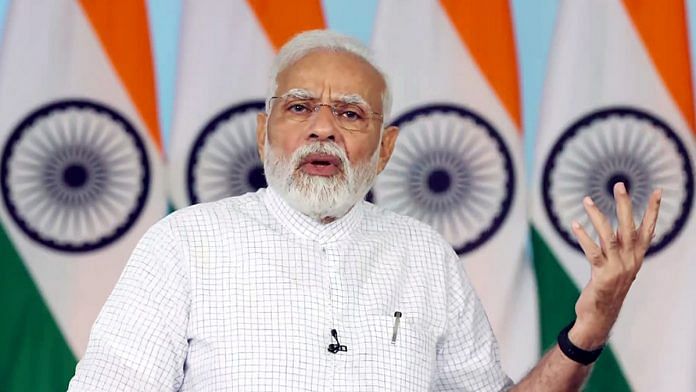New Delhi: “Urban Naxals” and “anti-development elements” stalled the construction of the Sardar Sarovar Dam in Gujarat for several years, Prime Minister Narendra Modi said Friday as he called for faster environment clearance to projects for ushering in development.
Contrary to the claims that the project would harm the environment, the area surrounding the dam has become a “teerth kshetra” (place of pilgrimage) for environment lovers, Modi told environment ministers from states and union territories after virtually inaugurating the National Conference of Environment Ministers in Gujarat.
Activists associated with the Narmada Bachao Andolan — considered among the most powerful social environmental movements in India — had spearheaded the protests against the Sardar Sarovar Dam for social as well as environmental reasons.
Coined in 2018, the term “Urban Naxal” is generally used to describe anti-establishment protesters who oppose the government’s actions and policies. Last month, Gujarat Chief Minister Bhupendra Patel had also accused “Urban Naxals” of opposing the Sardar Sarovar Dam on the Narmada river to deprive his state and arid Kutch region of water and development.
“It should be our endeavour that by raising the name of the environment unnecessarily, no obstacle should be allowed to be created in the quest of Ease of Living and Ease of Doing Business. We have to remember that the faster the environment clearance is available, the faster the development will also take place,” the prime minister asserted.
The Modi government has already introduced a slew of changes to forest regulations and the Environment Impact Assessment process, which environmentalists say will make it easier to obtain clearances with less oversight. Some of these changes were brought in through notifications and office memorandums, without public discussion.
In a statement, the government said the two-day conference was being organised to enhance cooperative federalism and promote center state collaboration for achievement of climate, environment and forestry related goals.
The conference comes after India submitted its updated climate pledges to the United Nations Framework Convention on Climate Change in August, ahead of the COP27 in November.
During his address, Modi reiterated the long-term goal of achieving net zero emissions by 2070 and urged ministers to move towards a circular economy. Forest fire management should be “technology driven and robust”, he said.
Also Read: Gujarat CM labeled Medha Patkar urban Naxal but Narmada Andolan never saw this cancel culture
Climate action plans
Among the major issues to be discussed during the two-day conference is updating the State Climate Action Plans.
In 2009, the Centre had directed all states and union territories to prepare State Action Plans on Climate Change (SAPCC), consistent with the strategy outlined in the National Action Plan on Climate Change (NAPCC).
The NAPCC was launched in 2008 with the aim of creating missions to help “adapt to climate change and enhance the ecological sustainability of India‘s development path”.
The missions include the National Solar Mission, National Mission for Enhanced Energy Efficiency, National Mission on Sustainable Habitat, National Water Mission, National Mission for Sustaining the Himalayan Eco-system, National Mission for a Green India, National Mission for Sustainable Agriculture, and the National Mission on Strategic Knowledge for Climate Change.
Other focus areas of the conference include segments on wildlife and wetland conservation, prevention and control of pollution, and agroforestry.
India updated its climate pledges to state that it would reduce emissions intensity of GDP by 45 per cent by 2030 as well as achieve about 50 per cent cumulative electric power installed capacity from non-fossil fuel-based energy resources by 2030.
A third new goal includes mobilising a mass movement — ‘LiFE’ or ‘Lifestyle for Environment’ — is also lined up for discussion at the conference.
Also Read: Why it’s not ‘anti-environment’ to be in favour of economic growth



